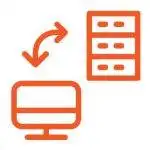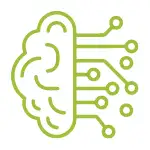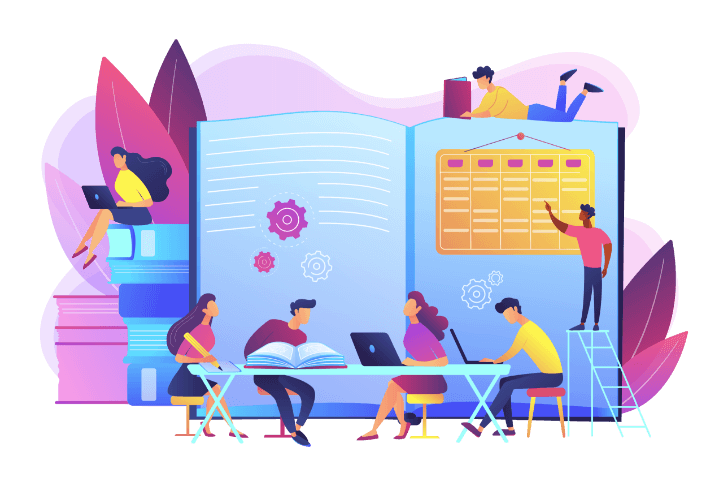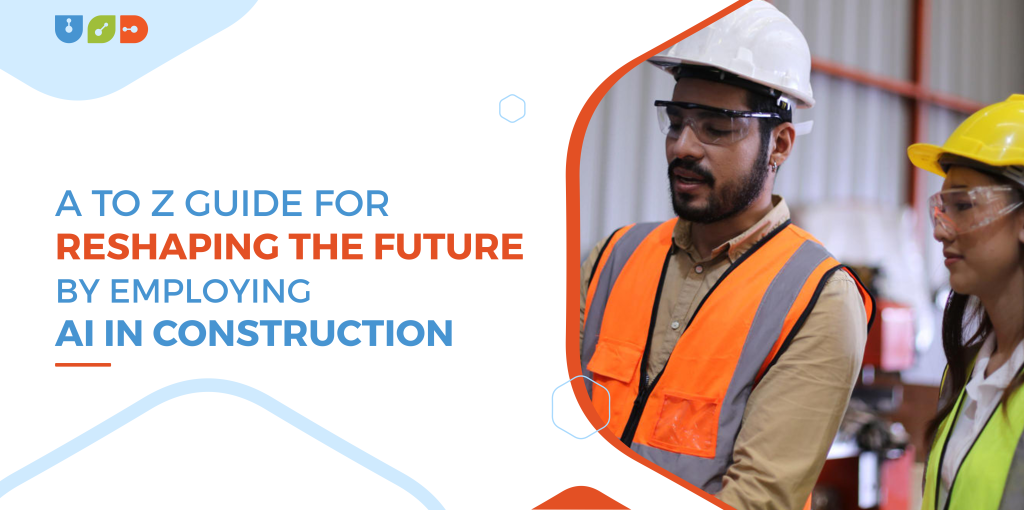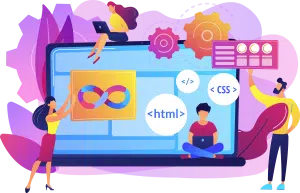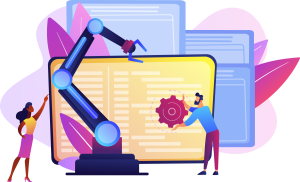Table of Contents
ToggleArtificial Intelligence (AI) is the most prominent of the latest technology advancements that are opening up limitless opportunities. None of the industries are left untouched by the various possibilities AI can equip IT services with. Whether you need to design, develop, secure apps, or create content, Open AI’s ChatGPT and Google Bard offer that. Moreover, AI image generators, AI logo makers, and other AI-powered tools are assisting millions of businesses worldwide.
AI in construction industry is also making waves as the industry is embracing cost-effective and resource-efficient technologies. We cover the numerous aspects that artificial intelligence offers to assist businesses while also explaining its software blueprint. Additionally, we will review the latest technology trends that are forging new paths for the construction industry. Furthermore, we will discuss how a construction company can nurture the power of AI for sustainable growth.
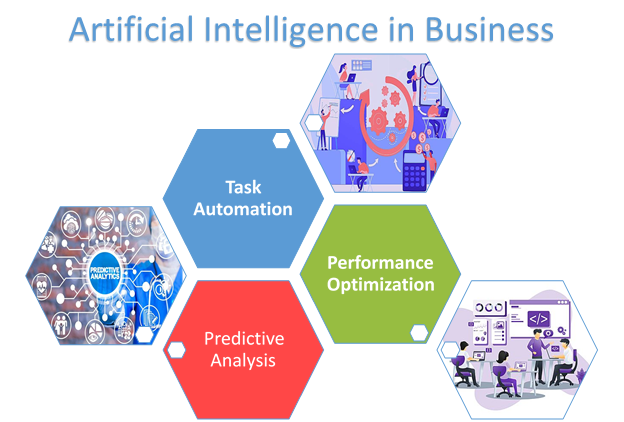
AI in Business
Unlike most of the latest technologies, artificial intelligence platforms are free to use, providing immense opportunities to entrepreneurs and enterprises. Many professionals are using AI capabilities to analyze, process, and present useful data rapidly to perform diverse tasks. It can write you code, articles, sales copies, or desirable content in a few minutes. Such are the benefits of AI for small businesses or enterprises, saving valuable time and resources. AI tools for small businesses also include several plugins that are available as per user needs.
By allowing people to write, code, secure, or improve their tasks, it can help them flourish at a faster pace. Be it a freelance professional or a development team, AI offers a solution for anyone who wants its assistance. One significant evidence of its global fame is that Open AI’s platform ChatGPT surpassed Google Search traffic on launch. Healthcare, Transportation, Fintech, Law Firms, and Retail sectors are some of the various industries that are reaping its benefits. Let’s review the blueprint for AI software to utilize its benefits at a better scale than such platforms.
Blueprint for AI Software
We aren’t limiting the discussion on Blueprint AI, which automates business processes, although it is a promising tool. Instead, we are discussing the solution design roadmap for developing custom solutions to solve business problems with AI. The process follows a simplistic approach to reap the maximum benefits of AI for small businesses or large enterprises.
The development process begins with the assessment of the problems that we want to solve, like costing, accounting, compliance, or scheduling. The next step is to gather useful data and choose the technology that could solve the underlying problem. Development and training of the models come next, which processes the data to eliminate issues. Once the testing is complete, deployment starts to avoid problems in the future. Several AI tools for small business owners are available over the web.
Construction Technology Trends
The latest construction technology trends are reshaping the industry for a better future, each construction company at once. AI in construction management is reducing the cost, time, and error margin while improving quality, reliability, and durability. The following technologies help companies to achieve objectives and deliver the best customer experience.
1. Digital Modeling
Architects use to work out 2D and 3D maps of buildings on paper, AutoCAD, or other software. Digital modeling made it easier for them by replicating the floor structures, room spaces, and other areas with precise measurements. It leverages the computing ability to generate or process specific requirements and propose plumbing, wiring, vents, and other vitals. Any construction company can use it to develop 3D models of plans without connecting each dot and line.
2. Equipment Management Systems (EMS)
Construction workers and project managers use various tools and equipment for performing tasks pertaining to their roles. Managing this equipment takes an additional effort to keep it working and maintain its condition with oiling, repair, and replacements. Equipment Management Systems (EMS) help in tracking usage of the construction equipment and its condition at projects. Moreover, it schedules fine-tuning and maintenance activities so the construction equipment supplier can deliver essential items on time.
Moreover, the system monitors the performance of every construction equipment from sourcing to disposal. It manages the lifecycle, automates its repair, and maximizes efficiency while improving safety through compliance. It aims at increasing the return on investment, keeping project expenses in control for effective construction management. Timely inspections assist in preventing shortages, whereas operator training helps in reducing costly wear and tear.
3. FDM and 3D Printing
Fused Deposition Modeling is the technique of 3D printing that utilizes hot molten materials to render 3D Prints. It uses a nozzle on the top of a build platform to build one layer at a time, giving it sufficient time to cool down and solidify. 3D printing is widely used for numerous prototyping and manufacturing purposes, including ready-to-use homes. Some construction companies print the entire home of choice on the construction site to prevent transportation damages.
It delivers precise, zero-waste results with affordable solutions not only in housing but also in other domains. Businesses are printing furniture, crockery, footwear, and even auto parts with this technology. The final product is a replica of the digital model that the printer is given and rarely requires any manual work. The Home Depot and many others are selling tiny house variants that are the product of this cutting-edge technique.
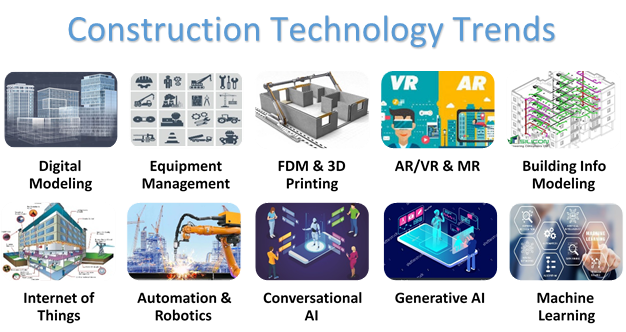
4. Garnering VR and AR
Virtual Reality (VR) and Augmented Reality (AR) are not new concepts, and much is available on their implications. The building and manufacturing segment is also utilizing AR and VR tech to improve the customer experience and assist purchase decisions. VR applications help create a virtual twin of your space for interior design and furniture placement. In contrast, AR helps in checking out for available space or colors of different flooring, painting, and decoration colors.
A combination of VR/AR features is also gaining momentum as MR (Mix Reality), which overlays physical, virtual, and augmented layers. It helps businesses offer various theme and décor choices to customers before beginning the work to build convenient homes. Architects, designers, plumbers, and electricians can use paid apps to uplift their efficiency and professionalism.
5. Harnessing Building Information Modeling
Building Information Modeling (BIM) entails the crafting of a virtual model to plan, organize, construct, and maintain an asset. The vital data in the BIM allows the architects, engineers, and builders to ensure collaboration via a single 3D model. It simplifies goal attainment, operations, maintenance, and management of buildings through data collection for informed decisions. It begins with drafting 2D models, transitioning into 3D designs, and finalizing as a BIM.
The components of a building information modeling are intelligent as well as geometrical and serve as storage for relevant data. Modification of a single element results in a change in the model, allowing stakeholders to coordinate better. The difference between a digital twin and a BIM is that a digital twin interacts with the physical asset virtually. It has seven layers that reflect paperwork, 2D modeling, isolated 3D modeling, unification, scheduling, cost, and sustainability.
6. Internet of Things (IoT)
The Internet of Things is a set of interlinked sensors, devices, and channels that work collectively as one smart unit. It comprises the pre-programming of event-based triggers, communication within devices, and cloud computing environments. There are several vital components of an IoT environment that record data and take necessary actions when certain conditions occur. Sensors take measurement readings on temperature, usage, inventory levels, and energy consumption.
They transmit the readings to smart devices and actuators, which respond to undesirable events to implement optimization. Cloud computing and networks allow managers to check on the performance and events of web apps. Finally, the system is able to control lighting, regulate air conditioning, generate purchase orders, or send notifications. The network of components acts as a single unit capable of monitoring, controlling, and avoiding unnecessary expenses.
Smart Buildings
Smart buildings utilize this tech to optimize resource consumption by continuously sharing essential data. Such buildings manage their water levels, energy usage, heat maps, access control, and other vitals without much intervention. The programming and responsiveness of the building are easily modifiable through web apps in case of a change in purpose or policies.
Smart Homes
Smart homes are tech-enabled units that enable the owners to control thermostats, lights, appliances, and other devices. It usually uses a smartphone app to share essential metrics with homeowners and alert them whenever necessary. Smart new home construction allows users to track, intervene, or even modify its response to factors such as outside weather.
Smart Warehouse
The smart warehouse technology is a slight variation of a smart building that performs inventory management. It monitors the automation of stock receiving, storing, and dispensing through various devices in the network. The system not only performs basic regulatory tasks but also keeps track of inventory levels, predictive demand, and automation with robotics or computing.

7. Job Automation & Robotics
The advantages of task automation and robotics in the industry stretch beyond warehouse management. It covers the handling and placement of building materials and equipment, as in the case of 3D printing. Any technique that minimizes manual labor work falls under automation, while robotics is a fraction of automation. AI encompasses the management of documents, requests, workflows, and data pertaining to the design or development of automation. Solutions architect helps streamline repetitive work, data entry, and bulk processing or dispatch in time.
8. Knitting Conversational AI
Conversational AI uses natural language processing (NLP) models to understand and respond to users. Using this type of AI in construction management allows teams (especially diverse ones) to collaborate effectively. Further, it replaces the jargon with common terms for simplifying interactions across different domain experts. It is capable of processing voice and written requests to analyze data and assist managers in decision-making.
9. Leveraging Generative AI
Generative AI possesses the ability to analyze larger data sets in less time to find solutions to problems. Imagine the reduction in stress as this tech marvel assists designers, builders, and engineers in gaining insights from past projects. It can optimize designs as per potential risks as well as provide references to past solutions and their performance. Such systems can bridge the gap between the global community of AEC professionals by allowing them to guide each other.
10. Machine Learning Algorithms
Anyone who knows a little about AI is also aware of the machine learning algorithms and model mapping. The mathematical models learn to trace patterns in large data sets to categorize and perform predictive analysis. Using machine learning, new home construction could leverage the trends of past projects and avoid potential mistakes. It can also trace demand shifts, material costs, and labor rate fluctuations to assess time or budget overruns in real time.
Nurturing the Power of AI in Construction
Cultivating the power of AI in construction apps or software is a choice worth making, as it opens up new avenues for growth. You can benefit from advanced AI-powered features through custom software development that aligns with your business objectives. The unique business needs of a company require a tailored solution to replace the legacy apps and optimize its performance.
1. Optimizing Custom Software Solutions
Custom software development is paving the way for a future where generic solutions won’t be desirable. It aligns your distinct business objectives and workflows with unique software development to create a best fit. Moreover, it allows you to optimize its performance and work processes to cope with your changing needs. Although standard solutions offer various modules, customization ensures low-cost, top-quality, high-performance construction software programs.
AI can uplift this optimization by highlighting potential risks, bottleneck situations, work repetition, and pattern recognition. Moreover, it assists in organizational communication and customer service by responding to their concerns instantly. AI integrations with third-party apps and legacy software enable scalability and sustainability while reducing resource consumption.
Construction ERP Software
Construction ERP software lets architects, engineers, and builders collaborate in various areas while managing resources. It merges the power of project management with industry operations through APIs and integrations. Companies can also manage vendors, suppliers, and client orders via the construction ERP software. AI can help link all desirable solutions that businesses in the industry might need, including all the essential features. It helps in optimizing the performance of components, enabling users to perform more tasks in less time.
Construction CRM Software
Although many platforms offer CRM tools for diverse industries, they are either too complex or lack security and user adoption. However, construction CRM software is built from scratch per user requirements and entails simplification of procedures. It allows the management of large data sets of customers along with their requirements and status in the sales pipeline. AI extensions can furnish advanced features in construction CRM software that assist in categorization and support. It rapidly provides information to clients, gathers requirements, and recommends suitable solutions.
2. Project Management Systems
Numerous brands offer construction project management software for small business owners that lack relevance to objectives. High cost, complexity, and steep learning curve are a few more issues delaying the quest for the best construction project management software. Customization leads you to goal-driven development, blending it with user-centric design. AI features help in processing speech or text input to perform tasks, making it easier to manage projects. AI tools automate the scheduling, timelines, resource allocation, task assignment, and progress mapping.
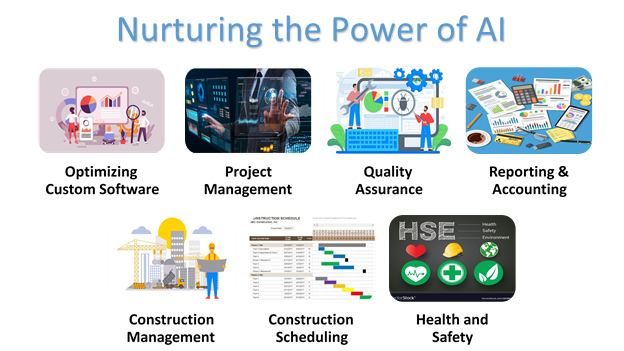
3. Quality Assurance Solutions
The advantages of AI in Quality assurance are largely relative to testing automation, which results in cost efficiency. It rigorously monitors the software and its performance to find potential risks or threats pertaining to security and operations. Furthermore, AI solutions can propose solutions for bugs and redundancies by optimizing code and APIs that improve overall performance. It aims at speeding up task completion, allowing users to do more in less time through optimization. It enhances the overall security of the construction software programs and their valuable data sets.
4. Reporting and Accounting Software
There are tons of accounting and reporting software that could lead to better decision-making with AI add-ons. Construction estimating software can prepare feasibility reports by analyzing the costs and benefits of alternates to assist a construction estimator. Likewise, construction bidding software can assist in quotations for winning contract bids. Furthermore, construction invoicing software helps in creating invoices for different customers per their required services.
However, the best construction accounting software must perform all the tasks mentioned above in one solution, eliminating the need for others. AI could create a strong integration among modules to perform estimation, bidding, and invoicing in real time. It can also find the relevant factors that determine a change in cost or pricing through a predictive analysis. Hire unique software development services to develop the best construction accounting software you need.
5. Seamless Construction Management Software
Artificial intelligence and machine learning capabilities provide comprehensive and seamless construction management software through custom software development. While AR and VR are enabling construction simulator environments, AI is optimizing the building process. Machine learning algorithms and models are finding patterns to grasp opportunities and reduce costs to boost productivity. In contrast, AI enables task automation and strong component integration via the best construction management software programs.
Automation allows the replication of optimal tasks from the construction simulator through robots and machines. Intelligent communication between such components avoids accidents or damage by a significant margin. AI enables the use of conversational tone among professionals or with clients to set project objectives and propose solutions. It can draft schedules, roadmaps, teams, and resources in minutes while also recommending solutions to potential issues.
The speed, quality, and reliability of the process significantly increase, providing many benefits to businesses and their clients. Consult unique software development services to transform your ideas into the best construction management software programs.
6. Time Management via Construction Scheduling Software
Time management is a crucial aspect of managing any complex business, let alone developing buildings or structures. Construction software programs need to manage two types of timelines besides the timely inflow of necessary materials. Construction employee scheduling software is essential to manage a workforce with relevant expertise in project phases. AI helps in analyzing which teams perform better together and the employees to assign where they fit. Moreover, it optimizes the sharing of tools and equipment among teams to deliver more with fewer resources.
Construction scheduling software requires more functionality to create overall development plans and project phases. It highlights which tasks will start before or after other ones and how much time each task will take. Adding slack in the project timeline is necessary as issues may arise, resulting in delays taking more investments than allocated. AI can assist in finding patterns and probable faults that could delay the project so you can prepare contingency plans.
7. Uplifting Health and Safety Compliance
The US Government imposes mandatory compliance with OSHA (Occupational Safety and Health Administration) standards for all industries. It proposes a list of regulatory guidelines for builders and developers to ensure their employee’s rights and prevent accidents. Construction insurance has distinct types pertaining to builder’s risk and worker’s compensation insurance. Construction accident lawyers and law firms assist with judicial cases of insurance and compliance failures.
AI can equip solutions with construction insurance, standard protocols, and vital preventive measures to ensure compliance. Furthermore, it can assess the nature of threats in each activity of the project and present useful statistics to avoid accidents. It can also trace past records of each instance to highlight critical areas that need training or improvement. Whereas the ample amount of data available to AI platforms can help find relevant judicial references or judgments.
Value Addition for Sustainability
Above all, sustainable living and business commencement are critical factors in today’s digital arena. It is not only essential for nature’s preservation but also gets you respect, authority, and capital benefits by switching choices. AI in the construction industry is also helping organizations gain sustainable growth by going green. Many construction software programs cater to new goals and help businesses in going green. Let’s review the critical components of these systems.
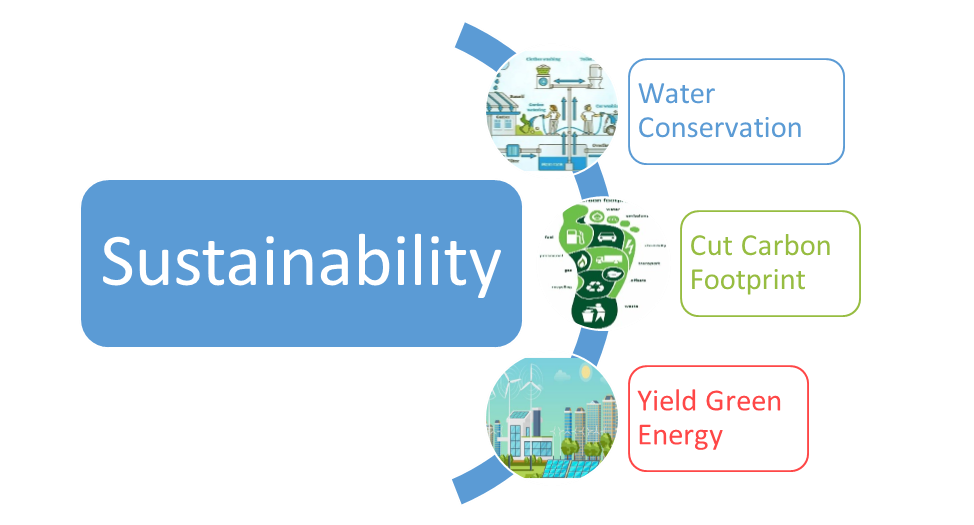
1. Water Conservation
IoT and AI-enabled systems are already implementing water conservation solutions by managing it effectively. Rainwater harvesting, smart taps, and leakproofing are some of the most efficient techniques for reducing consumption. AI can help achieve efficiency in smart homes and buildings by optimizing and regulating water levels via automation. Moreover, builders and developers must adopt techniques that utilize less water and recycle it for sanitation if possible.
2. X-ing Out Carbon Footprint
Carbon footprint is the second most important factor, including greenhouse gas emissions and non-biodegradable waste. Cutting down the consumption of such materials on construction sites could help achieve a lower footprint or even zero. Procurement modules in construction apps must use AI to assess the impact of a product on the environment. It must ensure the purchase of low-carbon alternatives by analyzing their ingredients and research data.
3. Yielding Renewable Energy
Green energy is also a critical element of sustainable growth as it produces non-toxic, eco-friendly wastes and cuts down costs. Solar energy, wind turbines, fuel-efficient vehicles, and modern tools can save big on fuel as well as electricity consumption. AI solutions can optimize resource usage by automation and predictive analysis while managing green energy efficiency. AI systems use weather and wind forecasts for fine-tuning energy production by adjusting blades or panels.
Zooming Out
The writing discusses the diverse uses of AI in business, specifically in the construction industry. We highlight the fundamental blueprint of AI software to cater to construction technology trends and how it can improve them. Task automation, performance optimization, and predictive analysis remain the core advantages of AI in the construction sector.
Moreover, the different types of solutions show why nurturing the power of artificial intelligence is favorable for a construction company. Value addition for sustainability and an eco-friendly business approach adds to the many benefits. Hire the services of Unique Software Development for cost-effective AI development to gain sustainable growth.







